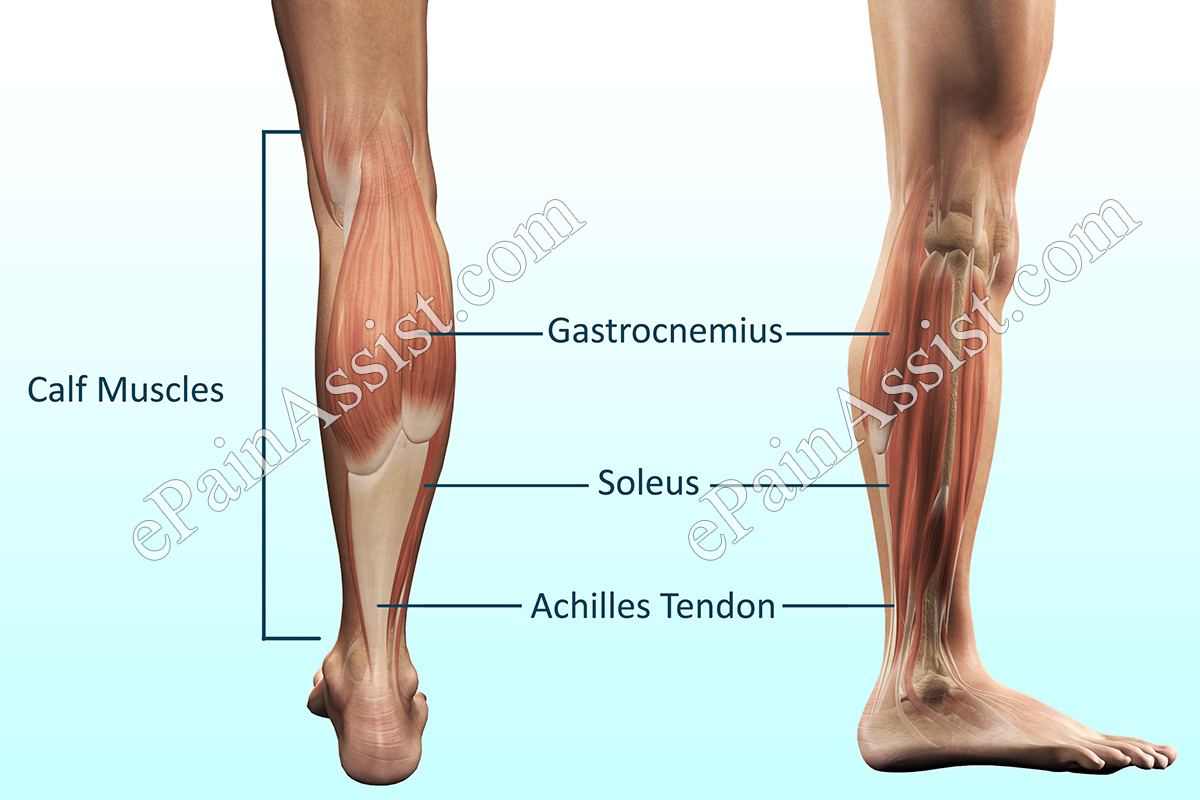Calf pain is caused by muscle pull, tear and sprain. Calf muscle consists of gastrocnemius and soleus muscle. Calf pain or Calf muscle pain is one of the common causes of leg pain.[1]

Causes of Calf Pain or Calf Muscle Pain[2]
- Calf Muscle Pull
- Calf Muscle Tear
- Calf Muscle Strain or Sprain
Calf Muscle Pull– Calf muscle pull results in micro tear and bleeding within muscles. Recovery can take 4 to 6 week depending on hematoma. Minor muscle tear with micro hematoma can recover within 2 to 3 weeks. Calf muscle pull is a very common injury with athletes participating in contact sports like football, basketball and ice hockey. Calf muscle pull often results from stretched muscles without any external direct impact upon the muscles.
Calf Muscle Tear– Calf muscle tear is serious injury and could take prolonged period for complete recovery. Tear could be partial or complete. Muscles tear occurs when muscle is stretched and direct external impact strikes the muscles in stretched position. The multiple directions of the forces within the muscle fibers cause separation and tear. Muscle tear may heal with scarring and result in chronic pain. Complete recovery may take 6 to 8 weeks.
Calf Muscle Strain– Calf muscle strain is serious injury associated with tear of the calf muscle and tendon. Muscle strain is extremely painful condition. Most of the strain occurs near the tendon which includes distal part of the muscles and proximal part of the tendon. Recovery is prolonged and can take over 6 to 8 weeks. In few cases, calf muscle strain may need surgery.
Calf Muscle Sprain– Calf muscle sprain is injury or tear of tendon of the calf muscles. Tear of the tendon takes a longer time to heal than the muscles because of inadequate blood supply to the tendon as compared to the muscles. Healing may take 8 to 12 weeks and in few cases, surgery may be necessary.
Diagnosis and Investigations for Calf Pain or Calf Muscle Pain[3]
- Clinical Examinations– Severe pain, hematoma, and muscle spasm.
- X-ray– Xray is performed to rule out fracture of tibia and fibula.
- MRI–
- Diagnose Muscle Tear
- Diagnose Hematoma (Blood Collection)
- Rule Out Fracture.
- Ultrasound–
- Diagnose Muscle Tear.
- Diagnose Tendon Rupture.
- Diagnose Hematoma.
Treatment for Calf Pain or Calf Muscle Pain[4]
Conservative Treatment for Calf Pain or Calf Muscle Pain-
- Rest
- Cold Compression
- Leg Elevation
Indicated For– Calf muscle Pull, tear, strain and sprain.
Restrictive Treatment for Calf Pain or Calf Muscle Pain-
- Apply Crape Bandage With Firm Pressure.
- Use Cane Or Walker To Ambulate.
Indicated For– Calf Muscle Pull, Tear, Strain and Sprain.
Medications to Treat Calf Pain or Calf Muscle Pain-
- Anti-inflammatory Medications (NSAIDs)
- Naproxen, Ibuprofen, Daypro or Celebrex.
Indicated For– Calf Muscle Pull, Tear, Strain and Sprain.
Physical Therapy (PT) for Calf Pain or Calf Muscle Pain.
- Stretching.
- Muscle Strengthening.
- Optimized Mobility and Flexibility.
- Optimized Range Of Motion Of Leg.
Indicated For– Calf Muscle Pull, Tear, Strain and Sprain.
Surgery for Calf Pain or Calf Muscle Pain
Repair of tendon or muscle tear.
Indicated For– Calf Muscle Tear, Tendon Tear, Muscle Strain and Tendon Sprain.
